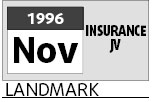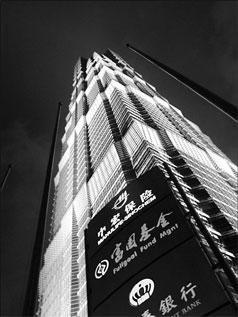

|
A woman discusses life insurance policies at a branch of Manulife-Sinochem Life Insurance Co Ltd in Nanjing, capital city of Jiangsu province. Manulife-Sinochem Life is the country's first joint venture insurance company between Canada's Manulife Financial and China Foreign Economic and Trade Trust & Investment Company, which was set up in 1996. |
Han Lin, a 39-year-old Chinese insurance worker, has become increasingly concerned about her job lately. But her worries don't particularly stem from her duties. She is concerned because of fears that one of the partners in a joint venture with the company she works for is about to leave.
And Han is not alone. Joint venture divorces affect many and these ventures have a tendency to split, usually due to irreconcilable differences.
And in the insurance sector, which has seen an increasing number of corporate intercultural marriages, there is the danger of suffering more divorces than Elizabeth Taylor.

Han has worked for Sino-US Metlife, the Beijing-based joint venture between US insurer Metropolitan Life Insurance Co and the State-owned (SOE) Capital Airport Group, for two years. Now insiders are suggesting that the Chinese partner is planning to quit as it looks to focus on its core business.
"As the State Assets Supervision and Administration Commission (SASAC), the watchdog of China's largest State-owned enterprises, tightened the performance evaluations of the top management of those SOEs, they could hardly be patient with the business development of their joint venture life insurance companies which usually lose money in the first seven to eight years," says Zheng Wei, an insurance professor with Peking University.
A difference in profit expectations between joint venture partners can be one of the major reasons for divorce. Chinese partners, especially private ones, are more eager to cash in and usually don't want wait long before they do so.
Allianz Dazhong Insurance Co is both a typical and the first example of this. In 2006, the China Insurance Regulatory Commission (CIRC) approved a stake change under which CITIC Trust and Investment Company (CITIC Trust) would take over Dazhong Insurance Co's 49 percent stake in the joint venture with Germany-based Allianz, which was established in 1999.
Analysts say there was a touch of bluster and claim that the long-term losses of the joint-venture insurer were the real reason for Dazhong's departure.
Dazhong had been longing for a listing but the once-profitable company saw a huge loss of 130 million yuan in 2003, the year it planned to go public. The next year was not much better; the company suffered a loss of over 50 million yuan, of which some 18 million yuan was attributed to Allianz Dazhong Insurance.
"After six years of losses, Dazhong lost its patience," says an analyst with China Securities. "And transferring its shares in the joint-venture life insurer is a good way to make profits in the short term."
But the partner seems happy with the split. "We are very pleased to find a new partner in CITIC Trust, which shares our strategy for rapid growth and expansion in the China life insurance market," says Werner Zedelius, board member responsible for growth markets of Allianz AG.
Such split-ups in part epitomize the Chinese insurance sector's opening process.
From 1980 to 2007, China's insurance premium sales have seen a growth of 1,650 times, jumping from 460 million yuan to 703.5 billion yuan, making insurance one of the most rapidly growing industries in the country.
In February 1979, the People's Bank of China decided to reopen the insurance sector at home, giving the industry a strong boost after more than 20 years suspension since 1958.
However, the development road is not always even. In the memory of Ma Mingzhe, chairman of Ping An Insurance, people in 1980s had no idea about the insurance at all.

And when Ping An, the country's first private insurance company opened in 1988, most of enterprises had a hard time accepting the fact that there would be two insurers in the country.
After Deng Xiaoping, the chief architect of China's reform and opening up, made his southern tour in 1992 and reinvigorated the reform process, banking, securities and trust sectors have become much more active in the market. But the insurance industry still remains relatively quiet.
Before the Insurance Law was launched in 1995, there were only three Chinese insurance companies and three foreign insurers in the market - The People's Insurance Company (Group) of China, Ping An, China Pacific Insurance Co, AIA, AIU and Tokio Marine & Nichido Fire Insurance Co.
The first round of the insurance entities' expansion came at 1996 when five new domestic players were given the go-ahead, including Taikang Life Insurance Co, New China Life Insurance Co, Huatai Insurance, Yong An Insurance and Sinosafe Insurance. Also at the same year, Manulife-Sinochem Life Insurance Co Ltd, the country's first joint venture insurance company between Canada's Manulife Financial and China Foreign Economic and Trade Trust & Investment Company, a member of the State-owned chemical industry giant Sinochem Corporation, was also set up.
As more insurance companies were established, regulating the industry was also on the government's agenda. On November 18, 1998, the China Insurance Regulatory Commission (CIRC), the insurance sector's regulator, was established. Before that, the People's Bank of China supervised the industry.
Among China's financial sector, the insurance industry was the first to be fully opened to foreign investors in line with China's commitments to the World Trade Organization.
Since December 11, 2004, in addition to compulsory insurance, foreign insurers have been allowed to run other areas of the insurance business, such as health insurance, group insurance and pensions. Meanwhile, all the geographical limits on foreign insurers' business expansions were also lifted. By the end of 2007, there were 43 foreign insurers from 15 countries and regions that had established 134 operations in China.
The only remaining restraint is that foreign insurers must team up with Chinese partners and the stake ceiling allowed by the regulator for foreign insurers is 50 percent. However, because of historical reasons, AIG and Allianz beat the regulator to the altar - so they could set their own terms of endearment. AIG runs its wholly owned subsidiaries in China while Allianz has a controlling - 51 per cent - stake in the joint venture.
With the sector growing at an average of 30 percent annually in the past two decades, an increasing number of foreign insurance giants have hopped on the bandwagon, but many don't find it easy to deal with this specific rule.
While the regulation attempts to protect China's emerging insurance sector, it is also a significant factor in the rising divorce rate among joint ventures.
Commonwealth Bank of Australia, the foreign shareholder in China Life-CMG Assurance Co, is in talks to partner a large-scale Chinese enterprise. The talks stem from the fact that the controlling shareholder, China Life Insurance Co plans to sell its stake in the joint venture to avoid competing with the joint venture as both are involved in the life insurance business.
Sources said that Bank of Communications is contacting China Life-CMG Assurance about taking the 51 percent stake.
Pacific-Antai Life Insurance Co, a joint venture between ING Group and Beijing Capital Group, also faces a similar stake swap.
"Due to the huge gap in management philosophy between the two parties as well as the culture shock, this split-up of joint ventures could have been forecast," says Wang Guojun, an insurance professor at Beijing's University of International Business and Economics (UIBE).
Wang cites the high salaries of the foreign management as an example. In a joint-venture insurance company, the foreigners are paid a salary at least the same as they made in their own country.
This is jarring for the Chinese partners, especially since a newly established life insurer needs at least seven or eight years to reach the break-even point.
According to Liu Liyi, who used to be the chief representative of Aon Group Beijing Office, good cooperation between the top management of the two parties is the precondition for the joint venture's success.
An exception to the seven or eight year rule is Shanghai-based Aon-COFCO, a 50:50 joint venture between the world's second largest insurance broker Aon Group and China National Cereals, Oils & Foodstuffs Import & Export Corp (COFCO), which started marking profits after a mere 18 months.
"Their cooperation will be smoother if the foreign party can have more leeway in management," says Liu.
(China Daily 10/13/2008 page2)













